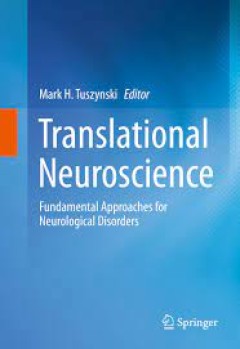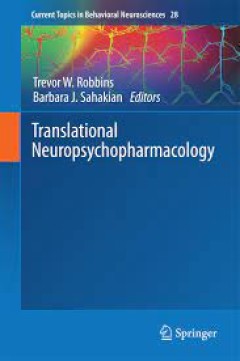Filter by

Translational Research in Audiology, Neurotology, and the Hearing Sciences
Translational Research is the interface between basic science and human clinical application, including the entire process from animal studies to human clinical trials (phases I, II, and III). Translational Research moves promising basic science results from the laboratory to bedside application. Yet, this transition is often the least-defined, least-understood part of the research process. Mos…
- Edition
- 1
- ISBN/ISSN
- 978-3-319-40846-0
- Collation
- XVIII, 265
- Series Title
- Springer Handbook of Auditory Research
- Call Number
- -

Translational Neuroscience
Translational Neuroscience offers a far-reaching and insightful series of perspectives on the effort to bring potentially revolutionary new classes of therapies to the clinic, thereby transforming the treatment of human nervous system disorders. Great advances in the fields of basic neuroscience, molecular biology, genomics, gene therapy, cell therapy, stem cell biology, information technology,…
- Edition
- 1
- ISBN/ISSN
- 978-1-4899-7652-9
- Collation
- XV, 584
- Series Title
- -
- Call Number
- -

Translational Neuropsychopharmacology
This book covers wide areas of animal and human psychopharmacology with clinical utility in the treatment of psychiatric and neurological (e.g Alzheimer's disease) disorders. The main theme is to develop a new paradigm for drug discovery that questions the claim that animal models or assays fail adequately to predict Phase 3 clinical trials. A new paradigm is advocated that stresses the importa…
- Edition
- 1
- ISBN/ISSN
- 978-3-319-33911-5
- Collation
- XII, 498
- Series Title
- Current Topics in Behavioral Neurosciences
- Call Number
- -

Translational Approaches to Autism Spectrum Disorder
This book addresses and synthesizes recent basic, translational, and clinical research with the goal of understanding the mechanisms behind autism spectrum disorder (ASD) and how they lead to altered brain function and behavior. Bringing clarity to these mechanisms will lead to more effective therapies for the various heterogeneous pathologies that comprise ASD. Currently there are few, if any,…
- Edition
- 1
- ISBN/ISSN
- 978-3-319-38657-7
- Collation
- XIV, 218
- Series Title
- -
- Call Number
- -

Evacuation Modeling Trends
This book presents an overview of modeling definitions and concepts, theory on human behavior and human performance data, available tools and simulation approaches, model development, and application and validation methods. It considers the data and research efforts needed to develop and incorporate functions for the different parameters into comprehensive escape and evacuation simulations, wit…
- Edition
- -
- ISBN/ISSN
- 978-3-319-20708-7
- Collation
- VII, 133
- Series Title
- -
- Call Number
- -

Glial Cells in Health and Disease of the CNS
A timely overview covering the three major types of glial cells in the central nervous system - astrocytes, microglia, and oligodendrocytes. New findings on glia biology are overturning a century of conventional thinking about how the brain operates and are expanding our knowledge about information processing in the brain. The book will present recent research findings on the role of glial cell…
- Edition
- -
- ISBN/ISSN
- 978-3-319-40762-3
- Collation
- -
- Series Title
- -
- Call Number
- 618.928 FLI

Ethical Issues in Behavioral Neuroscience
Behavioral neuroscience encompasses the disciplines of neurobiology and psychology to study mechanisms of behavior. This volume provides a contemporary overview of the current state of how ethics informs behavioral neuroscience research. There is dual emphasis on ethical challenges in experimental animal approaches and in clinical and nonclinical research involving human participants.
- Edition
- -
- ISBN/ISSN
- 978-3-662-44866-3
- Collation
- 4 b/w illustrations, 3 illustrations in colour
- Series Title
- -
- Call Number
- -

Essentials of Cerebellum and Cerebellar Disorders A Primer For Graduate Stud…
Essentials of the Cerebellum and Cerebellar Disorders is the first book of its kind written specifically for graduate students and clinicians. It is based on the 4-volume treatise, Handbook of the Cerebellum and Cerebellar Disorders (Springer, 2013), the definitive reference for scientists and neurologists in the field of cerebellar neurobiology. There have been fundamental advances in the basi…
- Edition
- -
- ISBN/ISSN
- 978-3-319-24551-5
- Collation
- 51 b/w illustrations, 61 illustrations in colour
- Series Title
- -
- Call Number
- -

Transcriptomics and Gene Regulation
This volume focuses on modern computational and statistical tools for translational gene expression and regulation research to improve prognosis, diagnostics, prediction of severity, and therapies for human diseases. It introduces some of state of the art technologies as well as computational and statistical tools for translational bioinformatics in the areas of gene transcription and regulatio…
- Edition
- 1
- ISBN/ISSN
- 978-94-017-7450-5
- Collation
- X, 185
- Series Title
- Translational Bioinformatics
- Call Number
- -

Traffic and Granular Flow '15
The Conference on Traffic and Granular Flow brings together international researchers from different fields ranging from physics to computer science and engineering to discuss the latest developments in traffic-related systems. Originally conceived to facilitate new ideas by considering the similarities of traffic and granular flow, TGF'15, organised by Delft University of Technology, now cover…
- Edition
- 1
- ISBN/ISSN
- 978-3-319-33481-3
- Collation
- XV, 639
- Series Title
- -
- Call Number
- -
 Computer Science, Information & General Works
Computer Science, Information & General Works  Philosophy & Psychology
Philosophy & Psychology  Religion
Religion  Social Sciences
Social Sciences  Language
Language  Pure Science
Pure Science  Applied Sciences
Applied Sciences  Art & Recreation
Art & Recreation  Literature
Literature  History & Geography
History & Geography